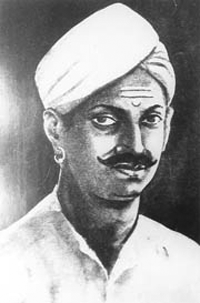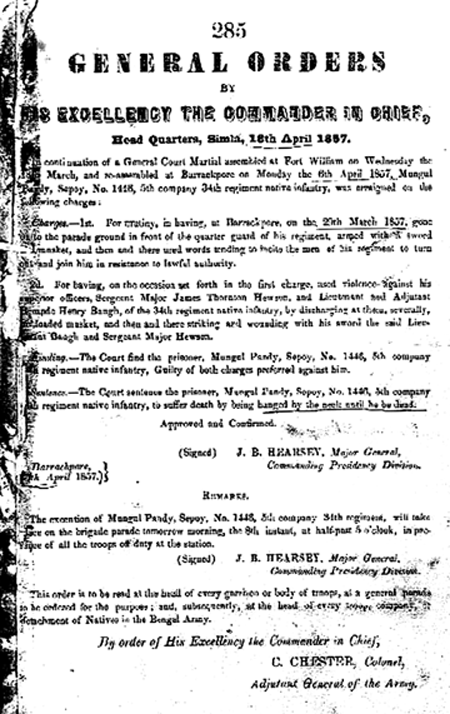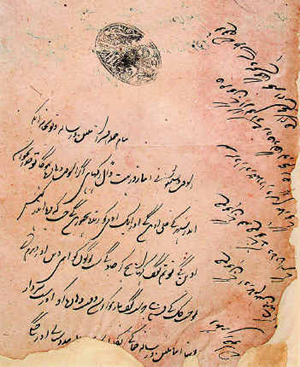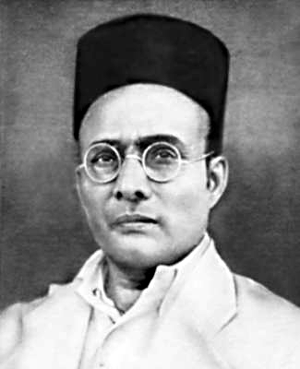Apr 23, 2025
Apr 23, 2025
by V. Sundaram
Today (Tuesday the 10th of May 2011) our beloved Bharatvarsha from Himalayas to Kanyakumari, from Rann of Kutch to the Bay of Bengal, will be paying its homage to the freedom fighters, martyrs and revolutionaries who started the First War of Indian Independence at Meerut in the then United Provinces of Agra and Oudh on the 10th of May 1857. Many of them boldly came forward to lay down their lives in the sacred cause of India’s freedom and became immortal martyrs. The saga of their sacrifice will continue to gleam and glow with deathless and resplendent glory for centuries to come.
Mangal Pandey
Most of the British historians like Charles Ball, G.W.Forrest, T.R.Holmes, M.Inns, J.W.Kaye, G.F.Macmunn, G.B.Malleson, C.T.Metcalfe, Earl Roberts and others have mischievously used the white man’s colonial term “Mutiny” to describe the first war of Indian independence. Sir John Lawrence was of the opinion that the Mutiny had its origin in the Army and its cause was the greased cartridges and nothing else. Sir John Seeley said that “The Mutiny was a wholly unpatriotic and selfish ‘sepoy mutiny’ with no native leadership and no popular support.”
Veer Savarkar (1883-1966), the incomparable patriot and a great son of Bharat Mata was the first historian who called the War of 1857 as the “The First War of Indian Independence”.
The sequence of events leading to an open rebellion and revolt at Meerut on 10th of May, 1857, can be summarised as follows. Several months of increasing tension and inflammatory incidents preceded the actual rebellion. Fires, possibly the result of arson, broke out near Calcutta on 24 January 1857. On february 26, 1857 the 19th Bengal Native Infantry (BNI) regiment came to know about new cartridges which allegedly had a casing made of cow and pig fat, which had to be bitten off by mouth. The cow being sacred to Hindus and pig haram to Muslims, both Hindu and Muslim soldiers refused to use them. Their English colonel confronted them angrily with artillery and cavalry on the parade ground, but later accepted their demand to withdraw the artillery, and cancel the next morning’s parade.
 The first hero and the first martyr of the War of Indian Independence in 1857 was Mangal Pandey. He was a Brahmin by birth, but he had the spirit of a true Kshatriya – the unquenchable spirit of an undaunted warrior. He loved his religion and his motherland more than his Life. For the sake of these sacred causes, he was ever willing to sacrifice his life without any hesitation of any kind. On March 29, 1857 at the Barrackpore (now Barrackpur) parade ground, near Calcutta (now Kolkata), 29-year-old Mangal Pandey of the 34th BNI, angered by the recent actions by the British, declared that he would rebel against his Commanders. When his Adjutant Lt. Baugh came out to investigate the unrest, Mangal Pandey opened fire against him but hit his horse instead. Mangal Pandey called upon his colleagues in the Army to rise in revolt at once. But his friends were not prepared to join him. Mangal Pandey impulsively jumped into the parade ground and told his fellow soldiers that they should rise up in revolt and drive away the treacherous English enemies out of our Holy Land. One English Sergeant Major Hughson tried to arrest Mangal Pandey. But before he could do so, Mangal Pandey’s bullet made him fall on the ground. Soon Lieutenant Baugh came on the scene and Mangal Pandey, with his sword, killed him also. Immediately thereafter, Colonel Wheeler arrived and ordered his soldiers to arrest Mangal Pandey. But Indian soldiers refused to do so. Colonel Wheeler was joined by Major General John B. Hearsey, Commanding Officer, Bengal Presidency Division.
The first hero and the first martyr of the War of Indian Independence in 1857 was Mangal Pandey. He was a Brahmin by birth, but he had the spirit of a true Kshatriya – the unquenchable spirit of an undaunted warrior. He loved his religion and his motherland more than his Life. For the sake of these sacred causes, he was ever willing to sacrifice his life without any hesitation of any kind. On March 29, 1857 at the Barrackpore (now Barrackpur) parade ground, near Calcutta (now Kolkata), 29-year-old Mangal Pandey of the 34th BNI, angered by the recent actions by the British, declared that he would rebel against his Commanders. When his Adjutant Lt. Baugh came out to investigate the unrest, Mangal Pandey opened fire against him but hit his horse instead. Mangal Pandey called upon his colleagues in the Army to rise in revolt at once. But his friends were not prepared to join him. Mangal Pandey impulsively jumped into the parade ground and told his fellow soldiers that they should rise up in revolt and drive away the treacherous English enemies out of our Holy Land. One English Sergeant Major Hughson tried to arrest Mangal Pandey. But before he could do so, Mangal Pandey’s bullet made him fall on the ground. Soon Lieutenant Baugh came on the scene and Mangal Pandey, with his sword, killed him also. Immediately thereafter, Colonel Wheeler arrived and ordered his soldiers to arrest Mangal Pandey. But Indian soldiers refused to do so. Colonel Wheeler was joined by Major General John B. Hearsey, Commanding Officer, Bengal Presidency Division.
Thus Mangal Pandey was surrounded by English soldiers on all sides in unbeatable numbers. Mangal Pandey vowed that he would rather die than fall into the hands of the enemy. Therefore he shot himself before the English soldiers could come near him. Unfortunately, he was only wounded and he fell on the ground. Mangal Pandey was arrested. The Britishers tortured Mangal Pandey in order to get exact information about the other revolutionaries who were behind him. But Mangal Pandey was not prepared to reveal their names. He decided that he would rather die than reveal their names and betray his Holy Motherland. So Mangal Pandey was ordered to be hanged by Major General John B. Hearsey and his execution was carried out at Barrackpur on 8th of April 1857.

Copy of the orders issued by Major General, John B. Hearsey
on 18th of April 1857 confirming the execution by hanging of Mangal Pandey
Within one month of the execution of mangal pandey at barrackpur in bengal, the news about his execution spread to all parts of India. Everywhere there was unrest among the soldiers. At Meerut there was a large military cantonment. 2,357 Indian sepoys. Besides, 2,038 British troops, armed with 12 British-manned guns were also stationed there. On April 24, 1857 the arrogant Commanding Officer of the 3rd Bengal Light Cavalry at Meerut ordered 90 of his soldiers to parade and perform firing drills. All but five of the men on parade refused to accept their new greased cartridges. On May 9, 1857 the remaining non-co-operating 85 soldiers were court martialled. 74 of them were sentenced to 10 years’ imprisonment with hard labour. 11 comparatively young soldiers were given five years’ imprisonment. The entire garrison was paraded and made to watch the condemned men who were stripped of their uniforms and placed in shackles. As they were being marched off to jail, the condemned soldiers raised slogans against their comrades for betraying them by failing to support them.
The very next day, on the 10th of May 1857, an open rebellion broke out at Meerut. The revolting Meerut soldiers reached Delhi next morning. The local infantry joined them, and together, they killed their own European officers and seized the city of Delhi from the British East India Company. Delhi became the centre of the revolt and Bahadur Shah, the Mughal Emperor, became its natural and legitimate symbol.
Thus began the First War of Indian Independence on 10th of May, 1857.
The rebellions sepoys all over the country turned towards Delhi and all the Indian Chiefs who took part in the revolt proclaimed their loyalty to the Mughal Emperor. The Mughal Emperor Bahadur Shah also wrote letters to all the Indian Chiefs and Rulers of India, asking them to organize a confederacy of Indian States to fight and replace the British Regime. He gave the clarion call for driving the British colonial and imperial rulers out of the soil of India on September 10 1857.
 I am presenting a copy of the proclamation issued by Bakht Khan, the Commander-in-Chief of the Rebel Mughal Army of Emperor Bahadur Shah on September 10th 1857.
I am presenting a copy of the proclamation issued by Bakht Khan, the Commander-in-Chief of the Rebel Mughal Army of Emperor Bahadur Shah on September 10th 1857.
Proclamation by Bakht Khan, the Commander-in-Chief of the rebel army in Delhi. He fears that the English may enter the town and exhorts Hindu and Muslim troops to fight the enemy with zeal. (National Archives of India, Collection No. 57, Serial No. 461, dated September 10, 1857.)
Veer Savarkar
(1883-1966)
When we remember the revolutionaries and martyrs of 1857, we should not fail to recall the fact that it was Veer Savarkar (1883-1966) who immortalized the names of these great freedom fighters in his brilliant and pioneering book “War of Indian Independence” published in the first decade of the 20th century. This book was proscribed by the British Government in India.
 In Great Britain, from 1906 to 1908, Veer Savarkar organized all the Indian students to come forward to launch an armed struggle to throw the British out of India. Keeping this larger, noble goal in view, he founded the Free India Society. Veer Savarkar thus organised the Indian students studying in England at that time for starting a movement for achieving the goal of indian independence through armed revolution. Veer Savarkar gave this bracing and rousing message to his fallen countrymen then in the bonded labour of British Imperial yoke.
In Great Britain, from 1906 to 1908, Veer Savarkar organized all the Indian students to come forward to launch an armed struggle to throw the British out of India. Keeping this larger, noble goal in view, he founded the Free India Society. Veer Savarkar thus organised the Indian students studying in England at that time for starting a movement for achieving the goal of indian independence through armed revolution. Veer Savarkar gave this bracing and rousing message to his fallen countrymen then in the bonded labour of British Imperial yoke.
“We must stop complaining about this British officer or that officer, this law or that law. There would be no end to that. Our movement must not be limited to being against any particular law, but it must be for acquiring the authority to make such laws ourselves. In other words, we want absolute independence.”
I have already referred to the fact that Veer Savarkar wrote his historic book on the 1857 Sepoy Mutiny (so named by the Colonial British Rulers), which he called as India’s First War of Independence, a terminology the Indian Government accepted after our Independence on August 15th 1947. Veer Savarkar envisioned a type of guerrilla war for Indian independence in the first two decades of the 20th century, along the lines of the famous armed Independence Movement of 1857. Thus Veer Savarkar became one of the first writers to describe the Revolt of 1857 as the “First War for Independence.” Karl Marx is also said to have referred to the Sepoy Mutiny of 1857 as the India’s First War of Independence.
Banned from publication throughout the British Empire in 1908, Veer Savarkar managed to smuggle his work on the First War of Indian Independence to expatriate Indian revolutionary Madame Bhikaji Cama (1861-1936), who obtained its successful publication in the Netherlands, France and Germany. The second edition was published by Indians in the US.
Later the great revolutionary martyr Bhagat Singh (1907-1931) printed the third edition of Veer Savarkar’s “Indian War of Independence (National Rising of 1857)” Widely smuggled and circulated, Veer Savarkar’s book attained great popularity in all parts of the world. This great work influenced rising young Indians and future revolutionaries, including Subhash Chandra Bose, Chandrashekar Azad, Rajguru and many others. Translations of Veer Savarkar’s book on the 1857 War into many Indian languages like Hindi, Bengali and Tamil were a big success. The Punjabi and Urdu translations of his book travelled far and wide while the Tamil translation became mandatory reading for the Tamil soldiers (who were in majority) of Subhas Chandra Bose’s Indian National Army between 1943 to 1945.
The War of 1857 was the first nationwide, organized and well-planned attempt to overthrow the British rule, launched by the people of India under the leadership of various kings, rulers and feudal lords from Kandahar to Kamakhya and Kashmir to Kanyakumari.
As R.C. Majumdar has rightly pointed out, the fire of revolution spread from Kolhapur in the South to Peshawar in the North, Gujarat in the West to Bihar in the East. And it was ‘continual upsurge of a popular character’. Azimullah Khan, the right hand man of Nana Saheb Peshwa, and Rangoji Bapu, the emissary of Satara Kingdom met in London to chalk out a detailed plan. Rangoji travelled to Turkey, Russia, and Egypt to seek support for the revolution in India. Azimullah and Nanasaheb travelled throughout the country to contact various kings, chieftains and feudal lords for a nationwide uprising. He travelled to Varanasi, Prayag, Bateswar, Gaya, Puri, Panchavati, Rameswaram, Dwaraka, Nasik, Abu, Ujjain, Badri and Kamrup and visited army camps to inspire the soldiers. Nana Saheb also wrote hundreds of letters to the kings and feudal lords regarding the preparations for the revolution. Nana had also raised a fund of five lakh pounds and deposited in British Banks for the purpose of revolution. The circulation of ‘Lotus’ among the self-respecting and patriotic soldiers in the army camps of the British rulers and ‘chappatis’ among rural people all over the country to alert them for the uprising was an amazing feat.
The martyrdom and self-sacrifice of the great heroes and heroines of 1857 War of Independence has been written in golden letters in the annals of Indian history. Even today, the children in the remotest villages of northern India sing the glory of the heroes and martyrs in ballads and folk songs. Among them, the name of Jhansi Rani Lakshmibai has been immortalized by Subhadra Kumari Chauhan whose immortal song, “Khoob ladee mardaanee…Vah to Jhansi wali Raanee thee” is on the lips of every Hindi speaking child of Bharat.
Nature renews herself and covers yesterday’s battlefield with green grass and flowers and the blood that is shed gives sustenance and stimulation to new life.
Sadhu Rangarajan and R.Vivekanadan, in their great and inspiring book titled ‘Saga Of Patriotism, Revolutionaries in India’s Freedom Struggle’ have rightly said:
‘Everyone sings the glory of Hinduism, the Vedas and Upanishads and the Puranas and Itihasas, but keep away when it is a question of fight to protect the Ram Mandir in Ayodhya or the Ram Setu in Rameswaram or for the rights of the Hindus in this Hindu Nation. When will Mother Bharat give birth to valiant sons and daughters and true sadhus and sants once again? When will Hindu society learn the lessons from past history and when will they proudly proclaim that this is their Eternal Motherland, the Hindu Nation, Bharatavarsha? Time alone could answer! Vande Mataram!’
Now it can be asked: Is it necessary at all to celebrate the Festival of Historic Personalities and Historical Events? I can answer this in the following words – aglow with light and aflame with fire - of Veer Savarkar:
“Why, then, should the historical functions be celebrated? To pay national gratitude we owe to those heroic souls. They should be celebrated as a mark of reverence and remembrance of the immense good those benevolent men have done to the world, because they have sacred sanction of ancient traditions. They are the clouds which shower the nectar of instruction. They are the monuments of virtues. They are the chemicals that act as an incentive to human thoughts and feelings. They are the preceptors who impart virtuous instruction to the youths. They are the living history of the deeds of noble heroes. Functions in their honour should be celebrated because of this. There are so many advantages and definitely no disadvantages. Especially we, Hindus, should take to these functions for emerging out of the present degraded state which was the result of want of self-respect and dutifulness. For, that is the only easy and sure path to the prosperity of the nation."
Thomas carlyle, in his ‘Heroes and Hero Worship’ wrote for all time when he declared:
“Consider all that lies in that one word past! What a pathetic, sacred, in every sense poetic, meaning is implied in it; a meaning growing ever the clearer, the farther we recede in time - the more of that same past we have to look through! History after all is true poetry. And reality, if rightly interpreted is greater than fiction.”
It is the detailed study of history that makes us fully aware of the poetry and music of the history of the Past! If we study the past with enthusiasm, sympathy and understanding, then the Past comes back to us alive, with many past events taking form, colour, gesture, passion and thought.
Here the words of G.M. Trevelyan come alive:
“The appeal of history to us all is in the last analysis poetic. But the poetry of history does not consist of imagination roaming at large, but of imagination pursuing the fact and fastening upon it. That which compels the historian to scorn, delights and live laborious days is the ardour of his own curiosity to know what really happened long ago in that land of Mystery which we call the Past. To peer into that magic mirror and see fresh figures there everyday is the burning desire that consumes and satisfies him all his life, that carries him each morning as a lover, to the library and the muniment-room. It haunts him like a passion of almost terrible potency, because it is poetic. The dead were and are not. Their place knows them no more and is ours today. Yet they were once as real as we, and we shall tomorrow be shadows like them……In the realm of history, the moment we have reason to think that we are being given fiction instead of fact, be the fiction ever so brilliant, our interest collapses like a pricked balloon. To hold our interest you must tell us something we believe to be true about the men who once walked the earth. It is the fact about the past that is poetic; just because it really happened it gathers round it all the inscrutable mystery of life and death and time. Let the science and research of the historian find the fact and let his imagination and art make clear its significance”.
Read Also: British Colonial Prejudiced Press Coverage
10-May-2011
More by : V. Sundaram

|
Japan sold Netaji and Netaji-dummy to British; In WW-I, Japan was an ally of British. Before WW-II, Japan-US trade war and political war started, this led to actual war between US and Japan. So British became an enemy to Japan by diplomatic manipulation as US - British alliance was there. After WW-II, Japan revived their old connection with British via spies. Japanese and British spies were enough linked before WW-II. Japanese spies agreed to eliminate Netaji. Motive was to appease the British and purchase security for Japan royal family. Thus, Japan sold Netaji to British and British eliminated him. The false news of air crash was Japan’s fabrication. In any controversial case, liar is to be suspected first. Netaji’s plan to start second independence war with the help of USSR was known to Japan. There was enough scope for British and Japanese spies to develop a common minimum program against pro-communist agenda of Netaji. Why should Japanese imperialism agree to patronize emergence of independent India as a permanent communist ally? Is it not more logical to fulfill British condition and purchase favor? Why Japan royal family was not tried as a war criminal? What is the mystery behind this favor? There is another point about gumnami baba. Who was he? Gumnami baba was a dummy created as a part of common minimum program of Japanese imperialism and British imperialism. In axis camp, creation of dummy by plastic surgery was a common practice. Hitler and Mussolini were having number of dummies. Japan sold Netaji-dummy to British. British deputed this dummy at faizabad of Uttar Pradesh, with a purpose to create confusion that as if Netaji’s death or life is doubtful. The confusion prevented the nation to be doubtful about role of Japan or British. So gumnami baba of faizabad is a common creation of Japanese spies and British spies. Never had he told the truth. If he had told anything, that must be lie. In a controversial case, liar is to be suspected. So, Japan sold Netaji to British and British executed him in secret. Japan sold Netaji-dummy to British and British deputed him at faizabad of Uttar-Pradesh. Japan surrendered to US-UK side on 15th august 1945. Netaji’s last flight was on 18th august 1945. A surrendered Japan was no longer an ally of azad hind. They worked as per their new mentors, the British. |

|
amazing piece of work by writer. |

|
Interesting and absorbing reading. It was from G.M. Trevelyan, that I took the sentinement " The dead were and are not. Their place knows them no more and is ours today. Yet they were once as real as we, and we shall tomorrow be shadows like them..." to mould them into the following verse, for one of my poems - Death of an Athiest" "Remember you all as pass me by Like you are now, so once was I As I am now, you too shall be Soon you all shall follow me" |